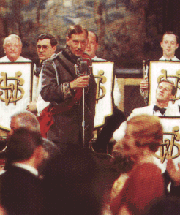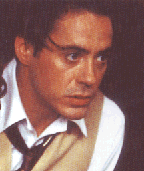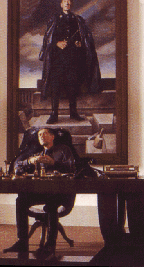|
 |
 |
| Richard III |
| 作者Author / William Shakespeare 威廉.莎士比亞 |
 |
|
Richard III
|
|
|
Richard Loncraine, an English director, also did The
Missionary (1982), The Gathering Storm (2002),
My House in Umbria (2003), and, more
recently, Wimbledon (2004) with Kirsten Dunst
and Paul Bettany. |
"Shakespeare was taught really badly at school -- rammed down my
throat. I didn't understand the language and that frightened me. I've
avoided seeing Shakespeare onstage for years," says Loncraine.
("McKellan") |
In the press kit for the film, Loncraine talked more about some of his
decisions in making the film."In the full text of Th. original play,
the story can seem over-complicated -- so for clarity's sake, we have
removed those supporting characters who detracted from the central
story. Our aim was always to keep whatever in the play was pertinent
400 years on." ("McKellan") |
The
first thing we have to look at, of course, is the setting. The film is
set in a dystopian Britain, a Britain of"what if". What if the Fascists
came to power? As Peter Samuel Donaldson points out, there
are"insistent parallels between Richard and Hitler, English fascism in
the 1930s and Nazi terror. In the Loncraine film, as in the Richard
Eyre National Theatre production of 1990 that preceded it, Ian
McKellen's Richard has affinities with Hitler but also with Oswald
Mosely; and its satire is directed in part against the segment of the
English aristocracy that supported or tolerated fascism in the years
preceding World War II."
And according to Barbara Hodgdon,"The stage production took as its
premise ‘what might have happened if Sir Oswald Mosely, leader of the
black-shirted British Union of Fascists had come to power in 1930s
Britain.'"
The details aren't always allusive. Richard Glouchester's black uniform
is actually the tunic of an SS Colonel General, minus the swastika
insignia. |
Who is Mosley, though? He was a British politician who founded the
British Union of Fascists in 1932 after meeting with Benito Mussolini
earlier in that year. His organization was strongly anti-communist and
argued for a programme of economic revival based on government spending
and protectionism. By 1934 Mosley was expressing strong anti-Semitic
views and his organization's marches through Jewish districts in London
led to riots. His union members wore black shirts and in many ways
mimicked Mussolini's notorious Black Shirts as well as Hitler's Nazi
party members. (This type of British Fascist is shown in the film Remains
of the Day ). |
During a symposium on"Shakespeare In The Cinema," Richard Loncraine,
the director, was asked"What is your view of filming historically
updated versions of Shakespeare s plays as opposed to period
presentations? |
 |
Ian McKellan as Richard III addressing the court
after the coup removing his brother from the throne. Source: McKellan
Shakespeare pages, Richard III Society pages.
|
Loncraine said,"I think both are valid, both have their place. It was
not my idea to set Richard III in the Thirties
that was decided by Richard Eyre, who directed it as a stage play, with
Ian McKellen. I never saw the stage play, so I've no idea what it was
like, but I believe we took the idea and ran with it, and extended it
on, which is what I'd hoped we would do. I think setting Richard
III in the fascist era was certainly a valid interpretation
and I decided to make a world that wasn't England, because I felt that
that was going to be confusing. We had period language that was written
four hundred years ago and I didn't want the language to clash with the
imagery by setting it in a period or a place that was known. Setting it
in an unknown time and place--you weren't in London, you weren't in
Strasbourg, you weren't in New York, you were somewhere in this
movie--I think helped to blur the lines between four-hundred-year-old
language and the more contemporary imagery. Shakespeare never performed
his plays in period costume, they were played in whatever actors turned
up on the day in, so Shakespeare obviously didn't think it was that
important, and neither do I." |
On one hand, I find his answer slightly disingenuous. You are obviously
in London for some scenes. I recognized it, and you may have as well,
if not from visits, from photos. And the scene at the beach when King
Edward learns of Clarence's death was Bath, also in England, so I think
to say he made a world that wasn't England doesn't work for me. I
certainly felt like I was in England. |
So once the setting is decided, and the period, some other things fell
into place. Casting Queen Elizabeth and her brother as Americans
emphasizes their"otherness" from the royal family. Both the Lancasters
and the Yorks were descended from King Edward III, so were royal or
noble. While Queen Elizabeth Woodville was from a noble family, it
wasn't that elevated. In the play (and during her life as well),
Richard harps on her being raised from being a commoner to queen. As an
American, she was definitely a commoner, and she and her brother are
parvenus in this world. And during this period, many English nobles
were marrying rich American heiresses. The British aristocrats wanted
the money, the Americans wanted the"class" that comes with titles. |
And having an American-English split also emphasizes the animosity
between the two branches of the family. Although we share a language,
there is often quite a bit of hostility, or perhaps rivalry would be a
softer word choice, between the two groups. For a funny take on it, see
Kevin Kline's psycho American in A Fish Called Wanda .
He represents what the English see as bad about Americans, but he
voices what Americans often think about the English. |
 |
| Robert
Downey, Jr. as Lord Rivers, brother of Queen Elizabeth. Source:
McKellan Shakespeare pages, Richard III Society pages. |
During
the symposium, Loncraine was asked: It is almost always necessary to
make cuts and other changes in the text when cinematically adapting a
Shakespeare play. What is your own philosophy or strategy for making
cuts, for updating antiquarian or obscure words, or for rewriting or
rearranging scenes? He answered:
"I do believe that you can cut the text. Shakespeare's plays were
almost never put on in their full-text form; Richard III runs
four-and-a-half hours, which is more than most people can deal with. We
made a very strong decision not to write any Shakespeare text because,
otherwise, why bother? You might as well find something else. So you
can change the text, and you can also move text around--it's a strong
Shakespearean tradition to take a scene or a line of dialog and move
it. Shakespeare did it all the time."
So that gives us some insight into the process, but not that much
really. It makes sense that McKellan make the cuts. He knew the play
better than anyone else involved, having played Richard on stage. And
we see why the film starts as it does. |
But the opening scene does much more than give us pre-history from Henry
VI, Part 3 . A New York Times review
of the movie starts like this: |
"The sound that introduces him is familiar to any fan of horror movies
of the past 20 years: it's the ominously amplified breathing of a
killer stalking his prey. Like the demon murderers of such popular
gore-fests as Halloween and Friday
the 13 th , he wears a mask, and his cold-bloodedness is
neatly established as he takes precise aim with his carbine at an old
man saying his prayers." (Brantley) |
So the opening is playing on the idea of horror movies--evil incarnate.
I also thought of Darth Vadar's breathing through his mask. Darth Vadar
is also evil, at least till the very end when he's redeemed by his son.
 |
Ian
McKellan as Richard III, sitting in front of an impressive portrait of
himself. Source: McKellan Shakespeare pages, Richard III Society pages.
|
The Times also points out"the single greatest
stumbling block (once you accept the Elizabethan verse) in translating
Shakespeare to film: soliloquies." But it points out that this is
mostly overcome in this play. In the film, Richard's first, famous
soliloquy starts as a public speech (and works really well as one,
too), and ends in the privacy of the toilet, while he mutters to
himself and looks in the mirror.
All in all, I thought the opening was brilliant. We go from the killing
of the king, to the celebration of the new reign. We can literally see
the dancing and joy. And it's full of ironic touches, as well. The
singer is singing a 1930s version of Christopher Marlowe's poem"Come
Live with me and Be My Love." Marlowe is Shakespeare's contemporary, of
course, and many critics point out Marlovian touches in Richard
III . It is also a pastoral poem, setting the mood
for"glorious summer" for this son/sun of York. The pun works nicely as
a speech, too. Easier to spot, I think. The initials on the band's
music stands are"WS", for William Shakespeare, of course. Another nice
touch comes later in the film when we see Richard plotting mayhem while
in the barn with a large black boar, his iconic animal.
This version also helps us understand Lady Anne in a new way.
Loncraine's version turns her into a chic, vacant thrill-seeker (her
drug and alcohol use alerts us that she is one of the"bright one
things" of the inter-war period.) As the Times puts
it:"Mr. McKellan's ring-sucking wooing scene, set by the very visible
corpse of her husband (whom he murdered) in a mortuary, becomes an
invitation to sadomasochistic pleasures that Anne hadn't really thought
of before but that might be fun." (Bentley) |
Changing the corpse from her father-in-law to her husband works just as
well, too, maybe even better as her grief for a father-in-law seems
awfully over the top. But of course, this changes the history a bit.
Prince Edmund died in battle about a month before his father was
murdered while a prisoner in the Tower of London. |
 |
Kirsten Scott-Thomas as Lady Anne. Source: McKellan
Shakespeare pages, Richard III Society pages.
|
I
loved watching Kristen Scott-Thomas do the wooing scene, as well. You
don't even think you're watching"Shakespeare." She and McKellan sound
wonderfully natural, a credit to their talents as actors.
Lady Anne is more visible in this version, and you really sense that
she and Richard are a couple. Her death scene is chilling, though. That
spider crawling across her face upset me the first time I saw it, and
it still does. It's so creepy. Did she die from a drug overdose?
Perhaps. But how many times have we heard Richard called a Spider? Was
that a visual clue?
But one lady is very much missed in this version. Queen Margaret is
sadly cut. A number of characters are cut--Queen Elizabeth's older
sons, a number of lesser characters, and that's fine. It cuts down the
confusion. But taking out Queen Margaret makes for some major changes
in the play. She's the only equal Richard had in the original and now
she's gone. Her curses are gone, too, taking with it much of the
mystical in the play. I can see why they cut her in terms of plot and
making the play more streamlined, but I think her absence subtly
changes the point of the play. Her evil wouldn't fit here. It wouldn't
do to have evil people all over the place when trying to focus on
Richard and the cult of personality. |
In his Newsweek Magazine review of the film Jack
Kroll notes," The film reminds us that the Bard was the Oliver Stone of
his day, creating a portrait of Richard that scholars have disputed
ever since." I very much liked this analogy. |
|
|
|
Sources
|
Brantley, Ben."Mesmerizing Men of Ill Will" New York Times ,
originally published Jan 21, 1996, Sec H p 1. Retrieved 9 February 2006
from New York Times Database.
Donaldson, Peter Samuel." Cinema and the Kingdom of Death: Loncraine's Richard
III ," Shakespeare Quarterly 53.2
(2002) 241-259.
Hodgdon, Barbara."Replicating Richard: Body Doubles, Body Politics," Theatre
Journal 50.2 (1998) 207-225.
Kroll, Jack."Review: Richard III" Newsweek
, Jan 29, 1996, p58. Retrieved 9 February 2006 from
Academic Premier Database.
"McKellan Shakespeare Film." Richard III Society http://www.r3.org/
"Shakespeare in the cinema: A film directors' symposium," Cineaste;12/15/98,
Vol. 24 Issue 1, pp 48 ff. |
|
|
|
|
|
|
